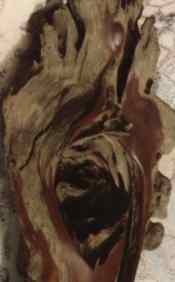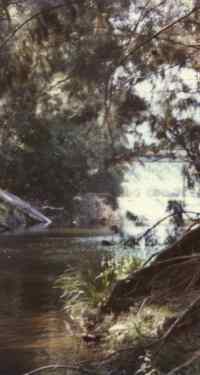






Above: Looking up into one of the few remaining large Australian Red Cedar Trees (toona australis) in the Bellinger Valley.
Below: Treble Cleft carved from Flooded or Rose Gum (eucalyptus grandis) recovered from the bed of Bellinger River adjacent to Leigh's property at Thora (near Bellingen on the North Coast of NSW Australia).


The Bellinger River by Leigh's Thora property - a rich source of old weathered wood for sculpturing.

|
The Medium and Methods I use
THE MEDIUM
My wood sculptures are all carved from the local timbers of the North Coast where I live. My favourites of these are the Australian Red Cedar (Toona Australis)and Rosewood (Dysoxylum fraseranum). But I always eye off every piece of wood for potential regardless of species when I am in the bush, down by the river or out scavenging in the estury.
I use all parts of the tree particularly those bits rejected by those seeking straight grain timber for furniture- mainly the buttresses, roots, forks, knotty or faulty limbs, or the butt of the tree.
Red Cedar is now a very rare commodity in Australia. NSW State Forests sell a few logs occasionally and very few trees are felled privately. Attending private auctions and responding to personal
contacts has enabled me to accumulate 3 tons of Rosewood and over 2 tons of Cedar, some of it cut over a hundred years ago. This stock is very valuable - newly cut Cedar and Rosewood limb, butt and root off-cuts cost $400 to $1,000 per cubic meter ($40/cub foot). Seasoned and sawn timber ranges from $2,500 to $5,000 per cubic meter depending on age, colour and size.
WHAT TO MAKE
Many Pieces of wood stand around for weeks or even months out in the open or in my workshop where I can eye them off while ideas evolve. Sketches for these pieces build up in my sketchbooks and on the layout board on the wall of the workshop until I resolve all my indecision. The many imaging hours spent gazing and conceptualising, mulling over design problems, sketching, refining and re-sketching at the embryonic stage is, I believe, the corner stone of a successful conclusion to a work and ensures the dynamics of the piece are manifested with vigour and confidence.
Once the decision is made and the piece started, I generally work continuously until it is completed. This is somewhat necessary a most timbers fade if left unsealed for long. Sometimes the piece I select will have such a dominant form or feeling that it dictates the final product. However, my doodlings with the pencil often lead to designs where the concept requires a particular shape of wood and if I do not have the right piece in stock, the idea remains in the fourth dimension.
TOOLS
I may start with something as savage as a chain saw and then rough in the shape with an "Arbourtec" cutter (a circular blade with chain-saw teeth which fits onto a 4" angle grinder). However I have a hand rasps or a chisel in hand for the vast majority of the time spent carving the form. In fact I find the rasp the best for taking down the wood as I find it easier to get the feel of the work with this simple tool - possibly due to the motion of the strokes following the contours. When a chisel finish is not called for, I sometimes use a disc sander (on larger pieces) but I usually do all the sandpapering by hand in steps from 100 grade to 320 grade.
FINISHING
Initially the inevitable unwelcome splits and faults
in the piece are considered to see whether the fault should be sculpted, or filled.
Generally only 5 to 10 percent of these faults really impair the artist’s vision of the finished product.
These areas are first sealed (as are all other places where moisture may enter the wood) with shellac.
The filler Leigh uses is a mixture of carefully colour graded and fine sifted dust from the hand sandings
off the same piece of wood, shellac, methylated spirits and white plaster.
This is applied in layers to replicate the natural grain.
In the end it is difficult to pick where filling has been used.
POLISHING
The type and degree of reflection of the surfaces of a sculpture has a profound influence on the impression in the observer. I can be pretty meticulous at times in getting the finnish I want. I do not like the highly reflective effect of the commercial products so, as my sculptures are for indoors I stick exclusively to French Polish.
The French polishing then begins; firstly rubbing with pumice and shellac,
then 24 to 30 thin coats of shellac, rubbing back the first two with 400 grade paper,
then the next with 800 grade and the rest with very fine steel-wool. Some pieces are
left with this extremely high polish. Most are more suited to a less reflective treatment.
These works are lightly rubbed with steel wool and then waxed with a very fine coat of
warmed bees’ wax and then polished. This final process of filling, French polishing and
waxing takes 3 to 5 weeks and ensures that the natural beauty of the wood is seen at its best,
in that deep glowing lustre obtainable only by traditional labour-intensive methods.
Whilst not ruling out limited use of waxes and oils for some works,
Leigh abhors the destruction of the timber’s character by the use of epoxy fillers and artificial finishes.
Leigh never uses tints, dyes or stains.
THE REWARDS
The real reward for this effort is not fiscal but the “lasting satisfaction I get from my own interaction with
my sculptures as they emerge, and particularly watching others smile and soak up the character the
sculpture evokes. Finally, the thrill as irresistibly they stroke the surface, gliding their hands over the form,
absorbing the warmth and sensuousness the sculptures will give forever.
|